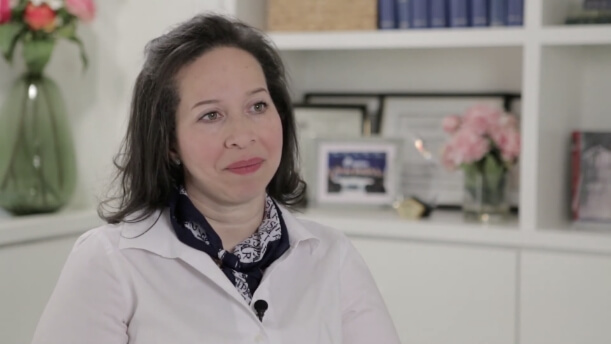
Tummy Tuck in New York City
Introduction to Tummy Tuck
Over time, many people gain weight around the midsection. For women, this is particularly common after pregnancy when the abdomen is stretched to accommodate a growing new life. When the abdominal area is over-stretched, however, the skin cannot snap back to its original form. The skin has three layers, the epidermis (outer layer), dermis (middle layer), and subcutaneous fat (inner layer). Once the dermis is damaged, it leaves unsightly marks called “striae.” The presence of striae, or stretch marks, is an indication that the overstretched skin has lost its elasticity, and no amount of exercise will allow the skin to revert to its original shape. Sometimes stretch marks will fade over time, but they cannot be erased through creams or lotions. The only way to eliminate the excess skin and stretch marks and create a flat abdomen is to cut it out surgically with a tummy tuck, or abdominoplasty. Dr. Constance Chen provides expert tummy tuck surgery in New York City for both men and women patients. Below is a guide to tummy tuck surgery. For more information, or to book a consultation, please contact us today.
What is a Tummy Tuck?
To remove excess skin and eliminate stretch marks from the abdomen, many women will choose to undergo an “abdominoplasty,” or tummy tuck. An abdominoplasty involves resecting the excess skin and striae from the lower abdomen, leaving a permanent scar that is located from hip to hip. If the patient’s body habitus allows it, the scar can be placed low enough to be hidden under their clothing. Before surgery, we advise our patients to bring a bikini bottom that they would like to wear so that we can try to design the scar within the borders of their clothing. All scars are red and raised in the first months after surgery, but they eventually fade and “mature” over the years. While techniques exist to optimize scars, a person’s genetic predisposition to scar formation will largely dictate how the ultimate scar appears. While some patients form large dark scars, other patients have a genetic tendency to form thin, light scars that can be difficult to see. Ultimately, however, patients who undergo an abdominoplasty must accept a permanent scar in return for an improved shape.
In many women, the changes in the abdominal shape are not just limited to the skin. After pregnancy or massive weight gain, women may also develop an abdominal bulge because the rectus abdominis muscles are pulled apart. The separation of the rectus abdominis muscles is called a “rectus diastasis,” and is due to a thinning of the connective tissue that wraps around the muscles. A rectus diastasis weakens the abdominal muscles and can make it difficult to lift objects. It can also cause lower back pain, poor pelvic alignment, and altered posture. Unfortunately, abdominal exercises usually do not improve the bulge; instead, the protrusion often becomes worse when the abdominal muscles are tensed. To correct a rectus diastasis, the stiff casing around the muscles, called the “fascia,” is sutured together surgically or “plicated” in an abdominoplasty. The resulting internal corset has the additional benefit of improving the patient’s waistline and can also alleviate lower back pain.
Who are the Best Candidates for Tummy Tuck?
As an established New York City practice, we’ve seen many aesthetic patients. The best patients for a tummy tuck are:
- At a stable weight with a BMI < 30
- Bothered by the appearance of your abdomen due to excess skin and fat
- Physically healthy
- Keeping realistic expectations from your procedure
- A nonsmoker

What are the Benefits of a Tummy Tuck?
Excess abdominal skin and fat can cause a variety of health problems, and a Tummy Tuck can help with some of them. While the primary reason to undergo an abdominoplasty is for cosmetic enhancement, a Tummy Tuck can also lead to additional health benefits:
- Strengthens your core
- Relieves back pain
- Reduces abdominal bulges
- Prevents rashes that may occur from overhanging skin
- Improves mobility

What’s the First Step?
If you are interested in getting a Tummy Tuck in New York City, the first step is to contact our office and schedule a consultation. During your first meeting with Dr. Chen, you will be able to bring up your concerns, have questions about the procedure answered, and create a timeline that works best for you. If you and Dr. Chen both feel that abdominoplasty is an appropriate procedure for your surgery can be booked. Please be open and honest about your surgical goals. We’re all on the same team, and good communication will help lead to better results.
What to Expect on the Day of a Tummy Tuck?
During an abdominoplasty, the patient’s abdominal skin is raised off of the abdominal fascia. This allows the plication to be performed to correct any rectus diastasis. In addition, the patient’s belly button, or “umbilicus,” is isolated, and a new opening is created for the umbilicus.
Tummy Tuck Recovery
Since a large potential space will be created, the patient will need drains after surgery. The drains usually last about 1-3 weeks. Patients should be able to walk immediately after surgery. Depending on how much extra skin and fat is removed, however, and how tight the plication is, patients may need to walk hunched over for a few weeks to allow their skin and fascia to stretch before they can stand up straight again. Sometimes, patients will feel numbness in their abdominal skin, but the sensation usually returns after several months.
Why Choose Dr. Chen for a Tummy Tuck
Dr. Constance Chen is a board-certified plastic surgeon with special expertise in using innovative, natural techniques to optimize her tummy tuck results for patients. Dr. Chen understands that every patient has unique concerns and treatment preferences, and is known for giving every patient highly individualized attention.
How Much Does a Tummy Tuck Cost in NYC?
The cost of a Tummy Tuck in NYC will vary from patient to patient. In order to get an accurate cost estimate, an in-person consultation with a full medical history and physical examination is necessary to develop a treatment plan. After the appointment, the office staff will be able to put together a cost estimate and answer any questions you may have.
Schedule Your Consultation
When you have decided to get a Tummy Tuck in NYC, we invite you to contact our office and schedule a consultation with Dr. Chen. She will listen to your aesthetic goals, and help you achieve a flatter abdomen and a healthier life.
REACH OUT TO USTummy Tuck FAQs
Is a Tummy Tuck painful?
A tummy tuck is performed under general anesthesia, so you will not feel pain during the surgery. Dr. Chen also uses a regional anesthetic block at the end of the procedure, so the postoperative pain is also minimized. That said, it is not unusual for patients to feel abdominal tightness and discomfort after surgery. While patients have different degrees of pain tolerance, all patients will be provided with postoperative pain medication. Many patients feel much better after 2-3 weeks and may even feel normal at one month, it is important to know that healing continues inside and it actually takes 6-8 weeks for full wound healing to be completed in a normal healthy patient. During the first stage of your recovery, you will experience fatigue, soreness, and notice swelling. It is completely normal to have mild to moderate pain at the beginning, and over time it will subside. You should take at least 2 weeks off from work, and your focus during this time should be to eat, drink liquids, and walk so that you can heal.
How many appointments will I need?
Dr. Chen will see you 2-4 times before your operation. These appointments include your initial consultation, one month prior to surgery to confirm the treatment plan, 2 weeks prior to surgery to go over your medical clearance and labs, and just prior to surgery for preoperative markings. For patients flying into NYC from out of town, some of the earlier appointments may be done by telehealth. After surgery, Dr. Chen likes to keep a close eye on her patient’s recovery. She will see you every week while your drains are in place, and then the appointments will be spaced out to 2 weeks, one month, 3 months, 6 months, and 1 year after surgery. For out-of-town patients, Dr. Chen requires that patients stay nearby for at least 2 weeks of follow-up. Subsequent appointments can be done by telehealth. The frequent preoperative and postoperative appointments ensure that your questions and concerns can be addressed both before and after surgery.
How long until I see results?
You will notice a difference in your abdominal shape immediately after surgery. Postoperative pain and swelling are normal, and it subsides more quickly in the first few weeks but it can take months for all of the swelling to go down. Subtle amounts of residual swelling can take 6 months to a year to disappear. All scars are red and raised at the beginning, and they take years to lighten, flatten, and “mature.”
Can I combine a Tummy Tuck with other procedures?
Yes, it is possible to combine a Tummy Tuck with a Breast Lift, Breast Augmentation, or Liposuction, for example. Patients should keep in mind that combined surgeries require more time under anesthesia and may involve a longer period for recovery. Depending on a patient’s underlying health status, it may also be safer to stage smaller surgeries so that it is easier to heal. If there is any part of your body that you have an interest in enhancing, please discuss this with Dr. Chen during your consultation so that she can give you the best options.
What are the risks associated with a Tummy Tuck?
Dr. Chen is committed to providing safe and positive outcomes for all of her procedures. Since the human body has infinite variability, however, all surgical procedures contain risk. The possible risks from a Tummy Tuck includes the following:
- Anesthesia risks
- Asymmetry
- Bleeding
- Cardiac and pulmonary complications
- Deep vein thrombosis
- Fat necrosis
- Fluid accumulation
- Infection
- Numbness or other changes in skin sensation
- Persistent pain
- Poor wound healing
- Possibility of revisional surgery
- Recurrent looseness of skin
- Skin discoloration and/or prolonged swelling
- Skin loss
- Suboptimal aesthetic result
- Unfavorable scarring


